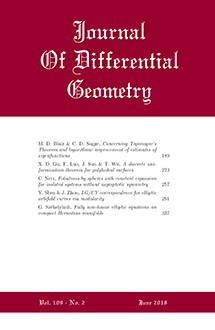Abstract
We prove a local well-posedness theorem for the $(n+1)$-dimensional Einstein equations in Lorentzian signature, with initial data $(\widetilde{g},K)$ whose asymptotic geometry at infinity is similar to that anti-de Sitter (AdS) space, and compatible boundary data $\widehat{g}$ prescribed at the time-like conformal boundary of space-time. More precisely, we consider an $n$-dimensional asymptotically hyperbolic Riemannian manifold $(M, \widetilde{g})$ such that the conformally rescaled metric $x^2 \widetilde{g}$ (with $x$ a boundary defining function) extends to the closure $\overline{M}$ of $M$ as a metric of class $C^{n-1} (\overline{M})$ which is also poly-homogeneous of class $C^p_{\mathrm{polyhom}} (\overline{M})$. Likewise we assume that the conformally rescaled symmetric $(0, 2)$-tensor $x^ 2 K$ extends to $\overline{M}$ as a tensor field of class $C^{n-1} (\overline{M})$ which is polyhomogeneous of class $C^{p-1}_{\mathrm{polyhom}} (\overline{M})$. We assume that the initial data $(\widetilde{g}, K)$ satisfy the Einstein constraint equations and also that the boundary datum is of class $C^p$ on $\partial M \times (-T_0, T_0)$ and satisfies a set of natural compatibility conditions with the initial data. We then prove that there exists an integer $r_n$, depending only on the dimension $n$, such that if $p \geqslant 2q + r_n$, with $q$ a positive integer, then there is $T \gt 0$, depending only on the norms of the initial and boundary data, such that the Einstein equations (1.1) has a unique (up to a diffeomorphism) solution $g$ on $(-T, T) \times M$ with the above initial and boundary data, which is such that $x^2 g \in C^{n-1} ((-T, T) \times \overline{M}) \; \cap \; C^q_{\mathrm{polyhom}} ((-T, T) \times \overline{M})$. Furthermore, if $x^2 \widetilde{g} , x^2 K$ are polyhomogeneous of class $C^{\infty}$ and $\widehat{g}$ is in $C^{\infty} ((-T_0, T_0) \times \partial \overline{M})$, then $x^2 g$ is in $C^{\infty}_{\mathrm{polyhom}} ((-T, T) \times \overline{M})$.
Citation
Alberto Enciso. Niky Kamran. "Lorentzian Einstein metrics with prescribed conformal infinity." J. Differential Geom. 112 (3) 505 - 554, July 2019. https://doi.org/10.4310/jdg/1563242472
Information





